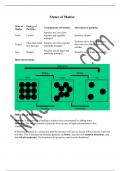Summary
Summary Chemistry Notes
- Course
- Institution
Master IGCSE Chemistry with these concise, easy-to-understand notes. Covering key topics like states of matter, atomic structure, and chemical bonding, these notes are perfect for exam prep and quick learning. Ideal for students and beginners in chemistry!
[Show more]



